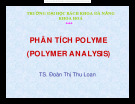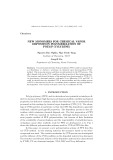
Chemical analysis of materials
-
Is a branch of polymer science dealing with analysis and characterisation of polymers. üThe complication of macromolecular chains, the dispersion in molecular weight, tacticity, crystallinity, orientation, composition of polymers etc. and complex morphological systems ⇒ analysis of polymer ≠ the small organic materials ⇒ Focus on viscoelastic properties, dynamic mechanical testing.
 114p
114p  buitiendung87
buitiendung87
 06-01-2011
06-01-2011
 347
347
 154
154
 Download
Download
-
It was demonstrated that Poly(p-Xylylene) (PPX) could be prepared from α,α’-Bis(Alkoxy or Aryloxy) –p-Xylenes via chemical vapor decomposition (CVD)- method. This is one-step process and there are side products by the CVD-process. This effect depends both on the CVD- condition and the properties of the starting monomer. The structure and thermal behavior of the material were characterized by FTIR, UVvis spectroscopy, elemental analysis, wide-angle X-ray diffraction, DTA and DSC.
 14p
14p  12120609
12120609
 01-06-2020
01-06-2020
 23
23
 2
2
 Download
Download
-
Complexometric titrations many metals form complex with a ligand: Cu++ + NH3 ⇔ Cu(NH3)++ Cu(NH3)2+ + NH3 ⇔ Cu (NH3)22+ Cu (NH3)22+ + NH3 ⇔ Cu (NH3)32+ Cu (NH3)32+ + NH3 ⇔ Cu (NH3)42+ Kf1 Kf2 Kf3 Kf4 Zn (NH3) complexes vs lg NH3 α .• theoretically could titrate Zn with ammonia • stepwise Kf very similar • difficult to know stoichiometry • to ensure all one form, need excess NH3 • titration never gives good equivalence point • can’t use monodentate ligand to titrate metals Titrations with EDTA • • • • use multidentate ligands e.g.
 13p
13p  doilan
doilan
 26-01-2013
26-01-2013
 47
47
 4
4
 Download
Download
-
-Systematic and random error -Accuracy vs precision -Significant figures -Average and standard deviations ENVI 15 - Analytical Chemistry Lecture 2 Quality Assurance Quality Assurance/Quality Control (QA/QC) Review Harris Chapter 5 A program to produce high quality data with known uncertainty. ENVI 15 - Analytical Chemistry Lecture 2 .
 11p
11p  doilan
doilan
 26-01-2013
26-01-2013
 76
76
 6
6
 Download
Download
-
Analytical chemistry is the study of the separation, identification, and quantification of the chemical components of natural and artificial materials.[1] Qualitative analysis gives an indication of the identity of the chemical species in the sample and quantitative analysis determines the amount of one or more of these components. The separation of components is often performed prior to analysis
 10p
10p  doilan
doilan
 26-01-2013
26-01-2013
 82
82
 5
5
 Download
Download
CHỦ ĐỀ BẠN MUỐN TÌM

















